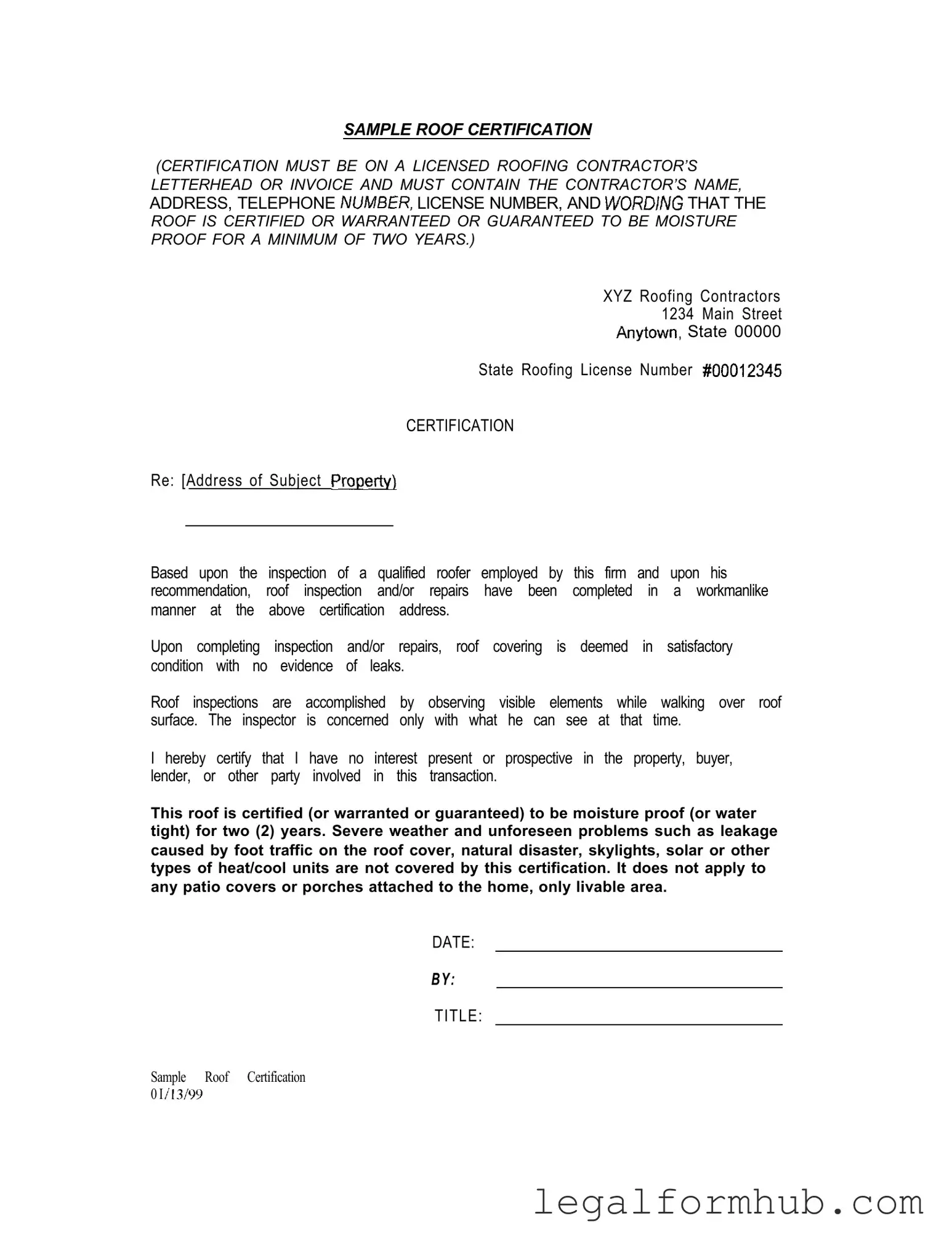The Sample Roof Certification form is similar to a Home Inspection Report. Both documents provide an assessment of the property's condition, focusing on the roof's integrity. A home inspection report includes a thorough evaluation of various systems within the home, including the roof, plumbing, and electrical systems. Like the roof certification, it is often required by lenders or buyers to ensure that the property is in good condition before a sale is finalized. Both documents aim to protect the interests of the buyer and provide peace of mind regarding the property's condition.
Another similar document is the Warranty Certificate for Roofing Systems. This certificate guarantees that the roofing materials and installation meet specific standards and will perform as expected for a designated period. Just like the Sample Roof Certification, it specifies the duration of coverage and outlines the conditions under which the warranty is valid. Both documents assure the property owner that the roof will remain free of leaks and defects for a specified time, reinforcing confidence in the quality of the roofing work performed.
A third document is the Roof Inspection Report. This report is typically prepared by a licensed roofing contractor and details the findings from a roof inspection. It often includes photographs and descriptions of any issues discovered during the inspection. Similar to the Sample Roof Certification, it provides an assessment of the roof's current condition and may recommend repairs or maintenance. Both documents serve as vital tools for homeowners and potential buyers to understand the state of the roof before making financial decisions.
The Maintenance Agreement for Roofing Services is another document that shares similarities with the Sample Roof Certification. This agreement outlines the terms under which a roofing contractor will provide ongoing maintenance services. It typically includes a schedule for inspections and maintenance tasks, ensuring the roof remains in good condition over time. Both documents emphasize the importance of regular upkeep to prevent significant issues, thereby protecting the property owner's investment.
Additionally, a Roof Repair Invoice can be compared to the Sample Roof Certification. This invoice details the specific repairs made to the roof and often includes a guarantee for the work performed. Like the certification, it provides assurance to the property owner that the repairs were completed professionally and that the roof is now in satisfactory condition. Both documents are essential for maintaining accurate records of the work done on the property.
The Property Disclosure Statement is another relevant document. While it is typically completed by the seller of a property, it includes information about the condition of the roof and any past issues. This statement serves to inform potential buyers of any known problems, similar to how the Sample Roof Certification reassures buyers about the roof's current condition. Both documents play a crucial role in real estate transactions by fostering transparency and trust between buyers and sellers.
The Arizona Motor Vehicle Bill of Sale form serves as a crucial document in the buying and selling of vehicles, providing a clear record of ownership transfer. By ensuring that both parties have an agreement on the vehicle's condition and sale terms, it helps to prevent misunderstandings. Additionally, you can find a handy template for this form at arizonapdfs.com/motor-vehicle-bill-of-sale-template, making it easier to create a comprehensive and legally binding agreement.
The Insurance Underwriting Report is also comparable to the Sample Roof Certification. This report is used by insurance companies to assess the risk associated with insuring a property. It may include details about the roof's condition and age, similar to the certification's focus on the roof's integrity. Both documents help determine the insurability of the property and the premiums that may apply, influencing the homeowner's financial responsibilities.
Another document is the Building Permit for Roofing Work. This permit is required before any roofing work can commence and ensures that the work complies with local building codes. While the Sample Roof Certification confirms that the work has been completed satisfactorily, the building permit ensures that it was done legally and safely. Both documents are essential in the lifecycle of roofing work, providing a framework for compliance and quality assurance.
Finally, the Homeowners Association (HOA) Approval Letter is similar in that it may be required for roofing projects in certain communities. This letter indicates that the planned roofing work complies with the HOA's guidelines. Like the Sample Roof Certification, it serves to protect property values and maintain the aesthetic standards of the neighborhood, ensuring that any modifications are acceptable to the community.
